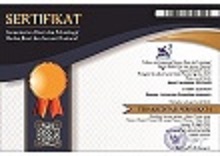KONDISI KUALITAS UDARA DI DALAM RUANGAN PEMUKIMANAN NON-KUMUH KOTA BANDUNG
Abstract
Abstract: This research was initiated by the factors of poor indoor air quality conditions. So that it can cause Sick Building Syndrome (SBS) or sick building syndrome. The purpose of this research is to measure the picture of air quality conditions in non-slum rooms. The sample in this study was Pasteur Village RW6, Sukajadi District which was selected based on criteria, namely including non-slum areas, as well as high community participation. The research method used was cross-sectional. The results showed an overview of indoor air quality in non-slum dwellings, humidity was above the required standard, thus triggering fungal growth rates that exceeded normal limits. The temperature parameter is in the required category, but based on the findings, some people are uncomfortable with the room temperature in the house. The Formadehilda and VOC parameters are within normal limits, this is indicated because most people do not use chemical products, rarely smoke in the house, and rarely start motorized vehicles in the house.
Keywords: Indoor Air Quality, Sick Building Sindrome (SBS)
Abstrak: Penelitian ini diawali oleh faktor kondisi kualitas udara di dalam ruangan yang buruk. Sehingga dapat menyebabkan terjadinya Sick Building Syndrome (SBS) atau sindrom bangunan sakit. Tujuan peneltian ini adalah untuk mengukur gambaran kondisi kualitas udara di dalam ruangan non kumuh. Sampel pada penelitian ini adalah Kelurahan Pasteur RW6, Kecamatan Sukajadi yang dipilih berdasarkan kriteria yaitu termasuk kawasan non kumuh, serta partisipasi masyarakat yang tinggi. Metode Penelitian yang digunakan adalah cross-sectional. Hasil penelitian menunjukkan gambaran kualitas udara di dalam ruangan pada rumah tinggal non kumuh, kelembaban berada di atas standar yang dipersyaratkan, sehingga memicu tingkat pertumbuhan jamur yang melampaui batas normal. Parameter suhu berada dalam kategori yang dipersyaratkan, namun berdasarkan hasil temuan sebagian masyarakat kurang nyaman dengan suhu ruang pada rumah tinggal. Parameter Formadehilda dan VOC berada pada batas normal, hal tersebut diindikasikan karena sebagian besar masyarakat tidak menggunakan produk-produk kimia, jarang melakukan aktivitas merokok di dalam rumah, serta jarang menghidupkan mesin kendaraan bermotor di dalam rumah.
Kata Kunci: kualitas udara di dalam ruangan, Sick Building Sindrome (SBS)Full Text:
PDFReferences
Adler, L. (2000). Common Indoor Air Pollutants: Sources And Health Impacts. Cooperative Extension Service, 1–3. Retrieved from http://www2.ca.uky.edu/hes/fcs/factshts/hf-lra.161.pdf
Bornehag, C. G., Sundell, J., Hägerhed-Engman, L., & Sigsgaard, T. (2005). Association between ventilation rates in 390 Swedish homes and allergic symptoms in children. Indoor Air, 15(4), 275–280. https://doi.org/10.1111/j.1600-0668.2005.00372.x
Brown, T., Dassonville, C., Derbez, M., Ramalho, O., Kirchner, S., Crump, D., & Mandin, C. (2015). Relationships between socioeconomic and lifestyle factors and indoor air quality in French dwellings. Environmental Research, 140, 385–396. https://doi.org/10.1016/j.envres.2015.04.012
Citraswari, H., Husein, A., & Muryoto. (2015). Hubungan Perilaku Penyehatan Udara di dalam Ruang Rumah dan Gangguan Kesehatan Keluarga di Kelurahan Caturtunggal Wilayah Kerja Puskesmas Depok III, Sleman, Yogyakarya. Sanitasi, Jurnal Kesehatan Lingkungan, 6, 157–164.
EPA. (2008). EPA’s 2008 Report on the Environment. EPA/600/R-07/045F. 366. https://doi.org/10.1016/B978-0-12-374849-2.00004-6
Escobedo, L. E., Champion, W. M., Li, N., & Montoya, L. D. (2014). Indoor air quality in Latino homes in Boulder , Colorado. Atmospheric Environment, 92, 69–75. https://doi.org/10.1016/j.atmosenv.2014.03.043
Fahimah, R., Kusumowardani, E., & Susanna, D. (2014). Home Air Quality And Case Of Pneumonia In Children Under Five Years Old ((In Community Health Center of South Cimahi and Leuwi Gajah, City of Cimahi). Makara Journal of Health Research, 18(1), 25–33. https://doi.org/10.7454/msk.v18i1.3090
Fitria, L. et al. (2008). Kualitas Udara Dalam Ruang Perpustakaan. 12(2), 76–82.
Global Health Data. (2017). GBD Results Tool | GHDx. Institue for Health Metrics and Evaluation. https://doi.org/10.1016/j.entcs.2010.01.004
Guimarães, R. P., Carvalho, M. C. R., & Santos, F. A. (2013). The influence of ceiling height in thermal comfort of buildings: A case study in belo horizonte, brazil. International Journal for Housing Science and Its Applications, 37(2), 75–86.
Indonesia, M. K. (2011). Peraturan Menteri Kesehatan Republik Indonesia Nomor 1077/MENKES/PER/V/2011 tentang Pedoman Penyehatan Udara dalam Ruang Rumah. https://doi.org/10.1360/zd-2013-43-6-1064
Kelly, F. J., & Fussell, J. C. (2019). Improving indoor air quality , health and performance within environments where people live , travel , learn and work. Atmospheric Environment, 200(November 2018), 90–109. https://doi.org/10.1016/j.atmosenv.2018.11.058
Lei, Z., Liu, C., Wang, L., & Li, N. (2017). Effect of Natural Ventilation on Indoor Air Quality and Thermal Comfort in Dormitory during Winter. Building and Environment. https://doi.org/10.1016/j.buildenv.2017.08.051
Lu, C., Deng, Q., Li, Y., Sundell, J., & Norbäck, D. (2016). Science of the Total Environment Outdoor air pollution , meteorological conditions and indoor factors in dwellings in relation to sick building syndrome ( SBS ) among adults in China. Science of the Total Environment, 560–561, 186–196. https://doi.org/10.1016/j.scitotenv.2016.04.033
Norhidayah, A., Chia-kuang, L., Azhar, M. K., & Nurulwahida, S. (2013). Indoor Air Quality and Sick Building Syndrome in Three Selected Buildings. Procedia Engineering, 53(2010), 93–98. https://doi.org/10.1016/j.proeng.2013.02.014
Padmonobo, H., Setiani, O., & Joko, T. (2013). Hubungan Faktor-Faktor Lingkungan Fisik Rumah dengan Kejadian Pneumonia pada Balita di Wilayah Kerja Puskesmas Jatibarang Kabupaten Brebes. Jurnal Kesehatan Lingkungan Indonesia, 11(2), 194–198.
Permana, A. Y. (2014). Fleksibilitas Ruang Perkotaan di Kawasan Balubur-Tamansari Kota Bandung (Issue 0011046901). Universitas Diponegoro Semarang
Permana, A. Y., & Wijaya, K. (2017). Spatial change transformation of educational areas in Bandung Spatial change transformation of educational areas in Bandung. IOP Conference Series: Earth and Environmental Science, 99, 012029. https://doi.org/10.1088/1755-1315/99/1/012029
Permana, A. Y., Susanti, I., & Wijaya, K. (2018). The Transformation of Gegerkalong Girang Area, Bandung City: amid Educative and Religious Areas. IOP Conference Series: Earth and Environmental Science, 213(1), 012022. https://doi.org/10.1088/1755-1315/213/1/012022
Rijal, H. B., Tuohy, P., Nicol, F., Humphreys, M. A., & Clarke, J. (2007). A window opening algorithm and UK office temperature: Field results and thermal simulation. IBPSA 2007 - International Building Performance Simulation Association 2007, 709–716.
Roser, M., & Ritchie, H. (2019). Indoor Air Pollution - Our World in Data. “Indoor Air Pollution”. Published Online at OurWorldInData.Org.
Sauni, R., Jh, V., Uitti, J., Jauhiainen, M., Kreiss, K., & Sigsgaard, T. (2015). Remediating buildings damaged by dampness and mould for preventing or reducing respiratory tract symptoms , infections and asthma ( Review ). Cochrane Database of Systematic Reviews, (2). https://doi.org/10.1002/14651858.CD007897.pub3.www.cochranelibrary.com
Sun, Y., Wang, P., Zhang, Q., Ma, H., Hou, J., & Kong, X. (2015). Indoor Air Pollution and Human Perception in Public Buildings in. Procedia Engineering, 121, 552–557. https://doi.org/10.1016/j.proeng.2015.08.1032
Tajima, K., Nonaka, I., Higuchi, K., Takusari, N., Kurihara, M., Takenaka, A., … Aminov, R. I. (2007). Influence of high temperature and humidity on rumen bacterial diversity in Holstein heifers. Anaerobe, 13(2), 57–64. https://doi.org/10.1016/j.anaerobe.2006.12.001
Takaoka, M., Suzuki, K., & Norbäck, D. (2016). Sick Building Syndrome among Junior High School Students in Japan in Relation to the Home and School Environment. Global Journal of Health Science, 8(2), 165–177. https://doi.org/10.5539/gjhs.v8n2p165
Tsongas, G. A., & Rioroan, F. (2016). Minimum conditions for visible mold growth. ASHRAE Journal, 58(9), 32–43.
Utomo, P. U., & Cahyono, T. (2015). Hubungan Jenis Atap dengan Suhu dan Kelembaban Kamar Tidur di Desa Karangmangu Rw 01 Kecamatan Baturraden Kabupaten Benyumas Tahun 2015. Kesehatan Lingkungan Masyarakat, 35, 112–114.
World Health Organization. (2018). Burden of disease of household air pollution for 2016. 389(10082), 1–4.
Wulandari, E. (2014). Faktor yang Berhubungan dengan Keberadaan Streptococcus di Udara pada Rumah Susum Kelurahan Bandarharjo Kota Semarang Tahun 2013. Unes Journal of Public Health, 3(1), 1–10.
Yau, Y. H., Chew, B. T., & Saifullah, A. Z. A. (2012). Studies on the indoor air quality of Pharmaceutical Laboratories in Malaysia. International Journal of Sustainable Built Environment, 1(1), 110–124. https://doi.org/10.1016/j.ijsbe.2012.07.005
DOI: https://doi.org/10.17509/jaz.v3i3.28134
Refbacks
- There are currently no refbacks.
Copyright (c) 2020 R.A Vesitara Kencanasari, Usep Surahman, Asep Yudi Permana, Hari Din Nugraha

This work is licensed under a Creative Commons Attribution-ShareAlike 4.0 International License.






